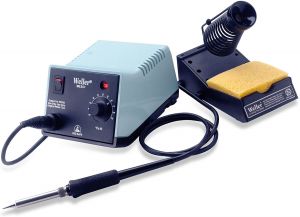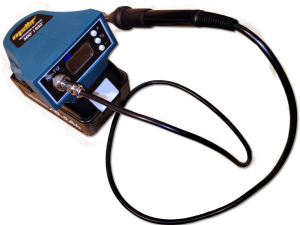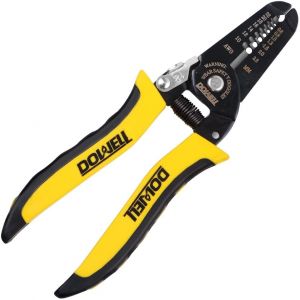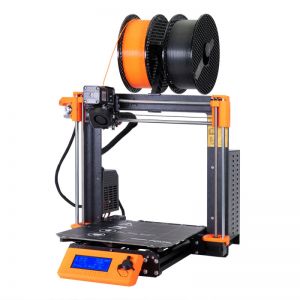Difference between revisions of "Tools For Beginners"
(Restructured soldering again after portable iron & supplies changes) |
|||
| (20 intermediate revisions by 4 users not shown) | |||
| Line 1: | Line 1: | ||
| − | + | There are a few things that all builders, even people using [https://robotcombatwiki.com/wiki/Kits robot kits], will need. If you don't already have some of these tools you should strongly consider getting them. | |
| − | |||
| − | |||
| − | |||
| − | + | [[File:Solder_Station.jpg|thumb|Weller Solder Station]] | |
| − | + | ==Soldering Irons & Stations== | |
| − | + | Soldering is the process of heating and melting soft metal to join wires to terminals and circuit boards, as well as each other. You'll have to learn how to solder in order to get solid, reliable connections that will withstand the impacts, shock and vibration typical in robot combat. '''[https://www.makerspaces.com/how-to-solder/ Beginner's guides]''' will help you with the basics. | |
| − | + | ||
| − | + | ===Workbench soldering=== | |
| − | + | A good, temperature-controlled soldering iron or station is a must. However, there are a lot of inexpensive and poor quality soldering tools out there that will hinder you from becoming proficient at good electrical connections. Consider getting a quality soldering station from a major manufacturer like Weller or Hakko. If you're making small bots, get a small conical tip for the iron. There are a lot of '''[https://makeradvisor.com/best-soldering-irons-beginners-hobbyists/ online guides]''' comparing soldering stations that may help you find the best one for you. | |
| + | |||
| + | [[File:Solder iron Generic portable.png|thumb|right|Cheap generic soldering iron that snaps onto a power tool battery]] | ||
| + | ===Portable soldering=== | ||
| + | You may find you have to make wiring repairs in "the pits" in between matches at an event. Most events offer power outlets for your soldering station, but sometimes you may be relegated to outdoor use only, or encounter other venue restrictions where having your own portable soldering tool is very convenient. Home center suppliers and online stores have cordless soldering tools that use power tool battery packs. In addition, there are various super-portable lightweight irons on the market such as the '''[https://pine64.com/product/pinecil-smart-mini-portable-soldering-iron/ Pinecil]''', and various TS100 or TS101 models. These run on DC power from any source you can tap, such as your car, larger robot battery packs, and even a '''[https://en.wikipedia.org/wiki/USB_hardware#USB_Power_Delivery USB PD]''' charger or power bank. | ||
| + | |||
| + | ===Supplies for soldering=== | ||
| + | Use only rosin-core solder for electronics. Leaded 60/40 solder (60% tin, 40% lead) is easier to use for beginners. It melts readily, helping you to avoid overheating and damaging components. The more difficult option is lead-free solder. | ||
| + | |||
| + | Use a dry brass sponge for cleaning the tip of the iron. This little bundle of wire wool often comes in a weighted holder for easy use. Push the end of the iron into the brass to scrape it clean, and re-tin it with a touch of solder before use or storage. | ||
| + | |||
| + | Consider getting a '''[https://makeradvisor.com/best-helping-hands-for-soldering Helping Hands]'''-type tool to hold your work while you solder; holding (for example) a wire, a motor, the solder, and the soldering iron can be difficult with two hands. Helping Hands will hold the pieces you are soldering, so you can concentrate on just getting a good solder joint. | ||
| + | |||
| + | There are many 3D printable soldering conveniences that can help you stay organized and ready for action. | ||
| + | |||
| + | ==Wire Cutters - Strippers== | ||
| + | [[File:Wire_Stripper.jpg|thumb|Wire Cutter / Stripping tool]] | ||
| + | While you could get by with a pair of scissors to cut wires and a sharp knife to strip off insulation, it can be difficult to strip the insulation without damaging the underlying wire. A proper wire stripper will make this job easier. A pliers-style wire stripper (as shown) is quick and convenient; choose one that can handle the sizes of wire you are using. | ||
| + | |||
| + | Squeeze-action 'automatic' wire strippers tend to work better for larger wires. These have a tension adjustment, and they will nick or break wires if the tension is set too high. | ||
| + | |||
| + | ==Drivers / Wrenches== | ||
| + | Nearly all bots use some fasteners to hold things together. Hex key or Allen key fasteners are the most popular since the fastener heads aren't as susceptible to damage as Phillips head fasteners. These come in many different styles and lengths for different uses. If your bot design requires you to remove a lot of fasteners to access the internals, consider getting a set that can attach to an electric drill or screwdriver. | ||
| + | |||
| + | ==Drills== | ||
| + | Electric drills are needed to make holes, to prepare material to be tapped (threaded for fasteners), and can also be used to quickly take your bot apart and put it together while making repairs and changes during an event. The quality and price of drills cover a huge range. Cheap drills are fine if you are only drilling aluminum or plastic, but they don't tend to last as long. If you are going to be drilling into steel or titanium you should get a higher quality drill from a brand name company. Consider getting a spare battery so that you won't run out of power during an event. While drills can be used to insert or remove fasteners from your bot, a large drill can be awkward to use with tiny robots; consider getting an electric screwdriver instead. | ||
| + | |||
| + | ==Cutting tools== | ||
| + | Being able to cut material is important when creating and repairing your robot. There are many manual and electric cutting tools available. One that is useful for all robots of all sizes is a rotary tool or Dremel. Although rotary tools have many different blades and wheels for cutting, abrasive disks are particularly useful. | ||
| + | |||
| + | ==3D printer== | ||
| + | [[File:Original-prusa-i3-mk3s-3d-printer.jpg|thumb|Desktop 3D printer]] | ||
| + | A 3D printer, which produces plastic parts under computer control, can be a helpful tool. 3D printing is normally done as part of preparation or building, rather than during a competition, and so you might be able to borrow one or use a service in order to print your bot parts. See [[3D Printing]] page for more details. | ||
Latest revision as of 07:03, 26 June 2024
There are a few things that all builders, even people using robot kits, will need. If you don't already have some of these tools you should strongly consider getting them.
Soldering Irons & Stations
Soldering is the process of heating and melting soft metal to join wires to terminals and circuit boards, as well as each other. You'll have to learn how to solder in order to get solid, reliable connections that will withstand the impacts, shock and vibration typical in robot combat. Beginner's guides will help you with the basics.
Workbench soldering
A good, temperature-controlled soldering iron or station is a must. However, there are a lot of inexpensive and poor quality soldering tools out there that will hinder you from becoming proficient at good electrical connections. Consider getting a quality soldering station from a major manufacturer like Weller or Hakko. If you're making small bots, get a small conical tip for the iron. There are a lot of online guides comparing soldering stations that may help you find the best one for you.
Portable soldering
You may find you have to make wiring repairs in "the pits" in between matches at an event. Most events offer power outlets for your soldering station, but sometimes you may be relegated to outdoor use only, or encounter other venue restrictions where having your own portable soldering tool is very convenient. Home center suppliers and online stores have cordless soldering tools that use power tool battery packs. In addition, there are various super-portable lightweight irons on the market such as the Pinecil, and various TS100 or TS101 models. These run on DC power from any source you can tap, such as your car, larger robot battery packs, and even a USB PD charger or power bank.
Supplies for soldering
Use only rosin-core solder for electronics. Leaded 60/40 solder (60% tin, 40% lead) is easier to use for beginners. It melts readily, helping you to avoid overheating and damaging components. The more difficult option is lead-free solder.
Use a dry brass sponge for cleaning the tip of the iron. This little bundle of wire wool often comes in a weighted holder for easy use. Push the end of the iron into the brass to scrape it clean, and re-tin it with a touch of solder before use or storage.
Consider getting a Helping Hands-type tool to hold your work while you solder; holding (for example) a wire, a motor, the solder, and the soldering iron can be difficult with two hands. Helping Hands will hold the pieces you are soldering, so you can concentrate on just getting a good solder joint.
There are many 3D printable soldering conveniences that can help you stay organized and ready for action.
Wire Cutters - Strippers
While you could get by with a pair of scissors to cut wires and a sharp knife to strip off insulation, it can be difficult to strip the insulation without damaging the underlying wire. A proper wire stripper will make this job easier. A pliers-style wire stripper (as shown) is quick and convenient; choose one that can handle the sizes of wire you are using.
Squeeze-action 'automatic' wire strippers tend to work better for larger wires. These have a tension adjustment, and they will nick or break wires if the tension is set too high.
Drivers / Wrenches
Nearly all bots use some fasteners to hold things together. Hex key or Allen key fasteners are the most popular since the fastener heads aren't as susceptible to damage as Phillips head fasteners. These come in many different styles and lengths for different uses. If your bot design requires you to remove a lot of fasteners to access the internals, consider getting a set that can attach to an electric drill or screwdriver.
Drills
Electric drills are needed to make holes, to prepare material to be tapped (threaded for fasteners), and can also be used to quickly take your bot apart and put it together while making repairs and changes during an event. The quality and price of drills cover a huge range. Cheap drills are fine if you are only drilling aluminum or plastic, but they don't tend to last as long. If you are going to be drilling into steel or titanium you should get a higher quality drill from a brand name company. Consider getting a spare battery so that you won't run out of power during an event. While drills can be used to insert or remove fasteners from your bot, a large drill can be awkward to use with tiny robots; consider getting an electric screwdriver instead.
Cutting tools
Being able to cut material is important when creating and repairing your robot. There are many manual and electric cutting tools available. One that is useful for all robots of all sizes is a rotary tool or Dremel. Although rotary tools have many different blades and wheels for cutting, abrasive disks are particularly useful.
3D printer
A 3D printer, which produces plastic parts under computer control, can be a helpful tool. 3D printing is normally done as part of preparation or building, rather than during a competition, and so you might be able to borrow one or use a service in order to print your bot parts. See 3D Printing page for more details.



